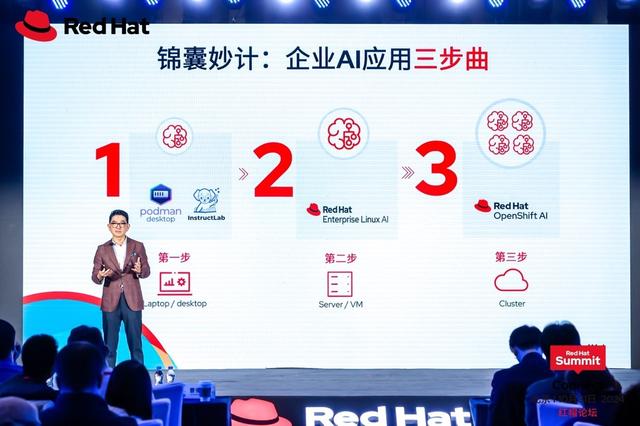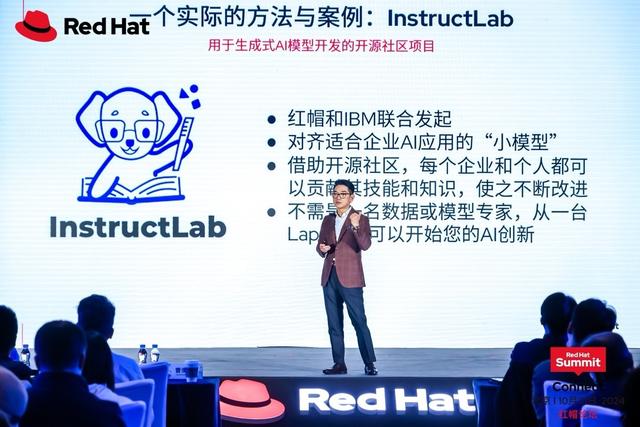From the early Unix ecosystem to today's generative AI and cloud computing, open source technology has always played a very important role in the development of computer science and technology. For many years, the open source movement has been driving innovation, collaboration and sharing knowledge. progress, and at every stage of computer technology development, it has demonstrated its unique advantages of low entry barriers, accelerating innovation, and promoting community cooperation and sharing of results.
As an enterprise open source solution provider, Red Hat has been focusing on open source since its establishment, and is committed to lowering the application threshold of AI by promoting the openness and sharing of technology. During the recently held 2024 Red Hat Forum, Red Hat Global Vice President Victor Tsao, President and President of Greater China, emphasized that to truly unlock the infinite possibilities of open source AI, companies must first deeply understand the internal logic and future trends of technology development, and at the same time closely align with the actual needs and long-term planning of enterprise IT.
He said that many companies currently hope to use AI to improve productivity and expand new business opportunities. Against this background, accelerating enterprise AI applications through open source methods has become a general trend. In order to further meet customers' cost demands, Red Hat also proposed a step-by-step implementation strategy, namely the "Three Steps to Enterprise AI Applications."

Specifically, in the first step, customers can try open source models and tools with minimal resource configuration, such as test running on a laptop with a CPU, without the need for an additional GPU card.
If the customer is satisfied with the test results, they can proceed to the second step, which is to rent computing power through cloud services for further expansion. Since the Red Hat platform can run on almost any cloud, customers can choose to use the enterprise's data center or public cloud resources. To deploy, if the model indeed meets the actual needs, the third step of large-scale deployment can be achieved.
It is worth mentioning that when customers carry out large-scale deployment in the third step, they do not need to worry about cross-cloud issues. Since the Red Hat architecture supports cross-cloud hybrid deployment, customers can choose to use different cloud services in different countries. Providers deploy, resulting in a more flexible architecture, more economical costs, and ultimately the best ROI.
In order to allow customers to implement the three-step process more smoothly, Red Hat and IBM also jointly launched the open source community project InstructLab, which complements the open source large language model Granite. Aella Wang, general manager of the Solution Architecture Department of Red Hat Greater China, said that InstructLab was designed for two main purposes. The first is to allow customers to use InstructLab and their own data to train models that meet their needs based on the Granite model. The output of InstructLab is divided into two parts: "knowledge" and "skills", both of which can be kept for internal use within the enterprise. The second is that through InstructLab, knowledge and skills can be fed back to the upstream management organization. After the management organization receives updates from customer feedback, it can be integrated into the community version of Granite and a new version released. In other words, InstructLab is the bridge between the community and customers.

As we all know, scene application is the "last mile" for AI empowerment. At a time when large models are in hot demand, although many companies are trying to improve production efficiency through large models, "ideals are full and reality is skinny." Most large models The model is actually not suitable for actual production scenarios, because a small mistake may bring risks. On the contrary, small models with fewer parameters and relatively limited training data, although not as good as large models in terms of multi-tasking or generalization capabilities, perform better than large models in specific tasks or fields.
Therefore, Red Hat proposed the concept of dedicated models (faithful purpose) a few years ago. Through dedicated models, enterprise data can be used to drive the generation of AI models. On the premise of ensuring the stability and security of the model, it meets the specific needs of the enterprise. Demand, the InstructLab mentioned above was born based on this concept.
In addition, Red Hat also introduced the "Community Edition" small model, which greatly reduces the need for real data through synthetic data, and can reduce the amount of data to one thousandth of the original. This method not only reduces computing power requirements and saves costs, but also significantly reduces energy consumption and is more environmentally friendly.
At the same time, by building the concept of "open labs", Red Hat can work with customers' advisory teams to find the most efficient application scenarios for the company's R&D, production, marketing, and customer support. Start successfully with a small application and then gradually expand to larger scenarios.
“Scenario applications are the areas where ISVs (Independent Software Vendors) and application providers are best at. Since many enterprises and industries have their own characteristics, Red Hat is also accelerating cooperation with local ISVs and solution developers. In addition, we are also accelerating cooperation with local ISVs and solution developers. Pay special attention to the co-creation model. By co-creating with ISVs and combining unique scenarios and joint solutions in various industries, we can help enterprises implement AI applications faster," said Zhao Wenbin, senior marketing director of Red Hat Greater China. Max Zhao added.
Finally, Red Hat also has corresponding plans to promote open source AI in China. Specifically, the first step is to promote the unique functions and advantages of AI through various market channels; the second step is to empower partners through the partner ecosystem. technical and advisory teams so that they can have a deeper understanding of Red Hat's AI technology to better support customers; the third step is to discuss with customers through the open laboratory how to apply AI technology to actual enterprise scenarios. .
It is reported that a domestic insurance company is already using Red Hat's AI technology to speed up the processing of code reviews and code merge requests. Previously, this company often faced the problem of low accuracy when using old tools, and sometimes it was accurate. The rate is even less than 95%, which will obviously cause considerable problems in the actual production environment. After the introduction of Red Hat's AI tools, the accuracy of code merging and review has been greatly improved, reaching the high standards of this customer.
During the 2024 Red Hat Forum, Red Hat also announced the list of winners of the 2024 Red Hat Asia Pacific Innovation Awards in China. Amway and Siemens Industrial Automation Products (Chengdu) Co., Ltd. won the award. Among them, Siemens Industrial Automation Products (Chengdu) Co., Ltd. (SEWC), as the sister factory of Siemens in Amberg, Germany, enjoys the reputation of being one of the most advanced factories in the world. In order to keep up with the pace of modern digital production applications, SEWC is faced with the dilemma of challenging production continuity, including insufficient system flexibility and scalability, low development efficiency, and inconvenient operations. By deploying Red Hat OpenShift, the factory built the Memo (Manufacturing Operations Modular Ecosystem) production support system. This system significantly improved the user experience and work efficiency of production line workers, put cutting-edge ideas into practice, and provided a system for industrial automation manufacturing execution. software applications set new benchmarks.
Yang Jian, manager of the information technology department of Siemens Industrial Automation (Chengdu) Co., Ltd., also shared his experience of cooperating with Red Hat in an interview. He said that compared with other suppliers, Red Hat's performance in response speed and sense of responsibility is very outstanding. , in the current rapidly changing AI technology environment, companies must continue to tune and improve when deploying AI, and Red Hat has maintained a humble and friendly attitude in this process. The cooperative environment of this co-creation model is very valuable. This is also an important reason why Siemens chose the Red Hat platform.
At the same time, he also said that after adopting Red Hat's solution, the factory realized the transformation from a monolithic architecture to a microservice distributed architecture. This brings two advantages. The first is that maintenance, upgrades and changes can be carried out without downtime; the second is that each change can be targeted at a smaller scope, which facilitates precise control and resource scheduling. This transformation will also It has become a major trend in the future development of manufacturing industry.
Looking to the future, in addition to continuing to explore microservices platforms, Siemens also plans to cooperate more with Red Hat in the field of virtualization to replace some existing solutions. In the future, Siemens will also further study how to make the AI platform better be integrated into its own resource system to further optimize the manufacturing process.